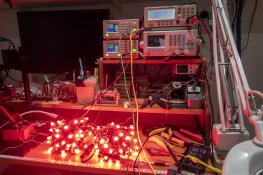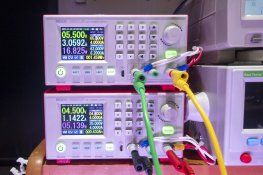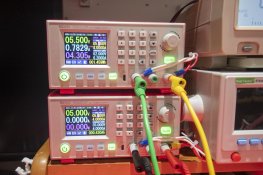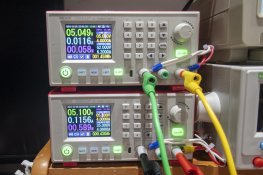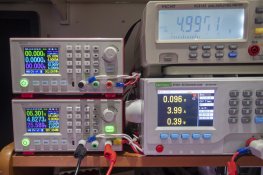Let's get some housekeeping for this thread out of the road first.
Opinions don't count nor does the this is how it's always been done.
Contribute with questions.
Contribute with you own experiments.
Feel free to ask me to test combinations.
do NOT EVER connect two power supplies together at the power supplies to get more current unless they are designed for it and have active load sharing
What I am testing and showing here is passive load sharing.
The first set of tests is fairly basic using seed pixels as they are reasonable low current and suffer from voltage drop at 100%
The following pictures are for 150 seed pixels at 100% driven with white from Vixen and an ECG-12R
The top psu is delivering power to the start of the string via 10A cabling about 1.5M long
The bottom psu is providing the power injection between 100 and 101
Power is feed both ways with Pos/Neg being continuous.
The bench meter is showing the voltage measured between pixels 50 and 51
Power Injection was 1.2M of maybe 22awg, it is thin but approximates the longer length/larger size we use outside.
Single Supply driving 150 pixels peak current around 1.3A
Single supply but with shared ground at pixel 100 peak current nearly 1.7A but pixels still went red due to v drop.
Dual supplies as per photos
test setup, the 3 bright bits are 50 seed pixels 100% white,
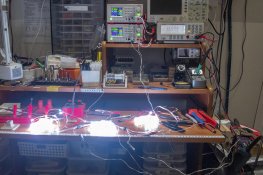
All the initial tests done with both supplies set for 5V
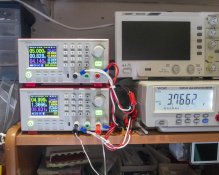
so here we see that PSU1 is providing 828mA to the start of the string with 3.76V being the voltage at pixel 50-51 when also getting power from pixel100-101
PSU2 is providing 1.366A center feeding at least 100 pixels
Now the constant talking point.... the supplies must be matched ..... this photo calls that busted... but we have more testing to do.
I deliberately set PSU2 that is doing the PI to 4.8v
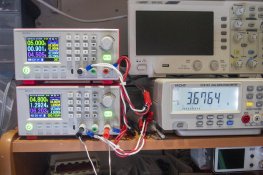
Net effect was an extra 70mA from PSU1 with the corresponding drop in current from PSU2 at the PI source.
Also there is a little extra voltage drop evident.
Honestly it was what i expected to see.
I have some normal 2811 pixels coming in very soon and will retest with them and thicker PI wiring.
For red/green/blue the max currents were lower hence the voltage drops where lower as well but the current split up remains constant
One thing for consideration is that center feed power is better generally than end feed.
One thing i would like to do is fire up the scope and look how the data stream looks at each point.
Cheers
Phil
Opinions don't count nor does the this is how it's always been done.
Contribute with questions.
Contribute with you own experiments.
Feel free to ask me to test combinations.
do NOT EVER connect two power supplies together at the power supplies to get more current unless they are designed for it and have active load sharing
What I am testing and showing here is passive load sharing.
The first set of tests is fairly basic using seed pixels as they are reasonable low current and suffer from voltage drop at 100%
The following pictures are for 150 seed pixels at 100% driven with white from Vixen and an ECG-12R
The top psu is delivering power to the start of the string via 10A cabling about 1.5M long
The bottom psu is providing the power injection between 100 and 101
Power is feed both ways with Pos/Neg being continuous.
The bench meter is showing the voltage measured between pixels 50 and 51
Power Injection was 1.2M of maybe 22awg, it is thin but approximates the longer length/larger size we use outside.
Single Supply driving 150 pixels peak current around 1.3A
Single supply but with shared ground at pixel 100 peak current nearly 1.7A but pixels still went red due to v drop.
Dual supplies as per photos
test setup, the 3 bright bits are 50 seed pixels 100% white,

All the initial tests done with both supplies set for 5V

so here we see that PSU1 is providing 828mA to the start of the string with 3.76V being the voltage at pixel 50-51 when also getting power from pixel100-101
PSU2 is providing 1.366A center feeding at least 100 pixels
Now the constant talking point.... the supplies must be matched ..... this photo calls that busted... but we have more testing to do.
I deliberately set PSU2 that is doing the PI to 4.8v

Net effect was an extra 70mA from PSU1 with the corresponding drop in current from PSU2 at the PI source.
Also there is a little extra voltage drop evident.
Honestly it was what i expected to see.
I have some normal 2811 pixels coming in very soon and will retest with them and thicker PI wiring.
For red/green/blue the max currents were lower hence the voltage drops where lower as well but the current split up remains constant
One thing for consideration is that center feed power is better generally than end feed.
One thing i would like to do is fire up the scope and look how the data stream looks at each point.
Cheers
Phil


